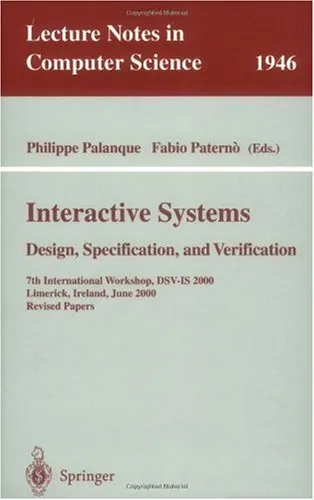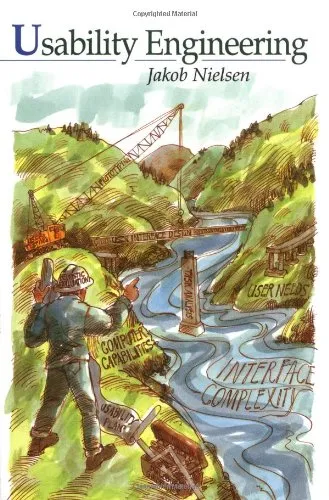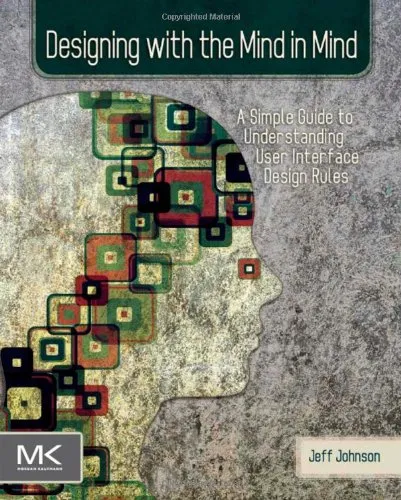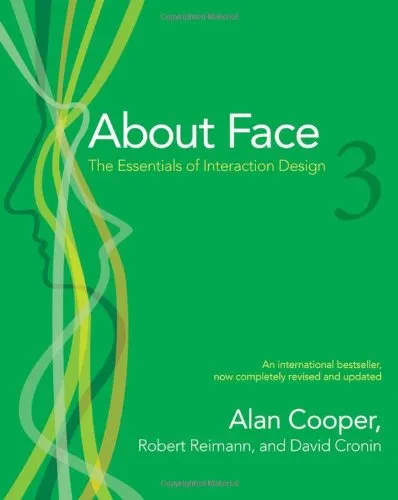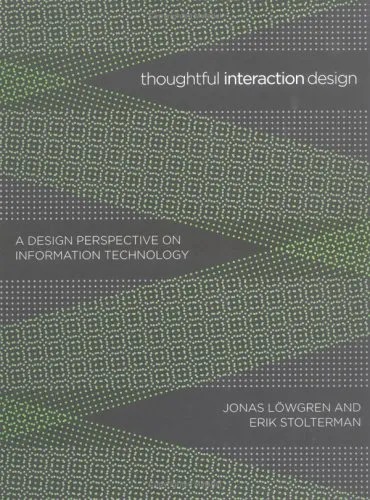Interactive Systems Design, Specification, and Verification: 7th International Workshop, DSV-IS 2000 Limerick, Ireland, June 5–6, 2000 Revised Papers
4.0
بر اساس نظر کاربران

شما میتونید سوالاتتون در باره کتاب رو از هوش مصنوعیش بعد از ورود بپرسید
هر دانلود یا پرسش از هوش مصنوعی 2 امتیاز لازم دارد، برای بدست آوردن امتیاز رایگان، به صفحه ی راهنمای امتیازات سر بزنید و یک سری کار ارزشمند انجام بدینکتاب های مرتبط:
معرفی کتاب
کتاب 'Interactive Systems Design, Specification, and Verification: 7th International Workshop, DSV-IS 2000 Limerick, Ireland, June 5–6, 2000 Revised Papers' یک منبع ارزشمند و جامع در حوزه طراحی، مشخصسازی، و بررسی سیستمهای تعاملی است. این کتاب، مجموعه مقالاتی است که از کارگاه بینالمللی DSV-IS 2000 گردآوری شده و نمایانگر تلاشها و پژوهشهای محققان برجستهای است که در این حوزه کار میکنند. سیستمهای تعاملی نقش ویژهای در دنیای امروزی ایفا میکنند و موفقیت آنها به طراحی دقیق، مشخصسازی صحیح، و آزمونهای کامل وابسته است.
خلاصه کتاب
این کتاب به بررسی سه جنبه اصلی سیستمهای تعاملی میپردازد: طراحی (Design)، مشخصسازی (Specification)، و بررسی اعتبار (Verification). هر فصل از کتاب به موضوعات مختلفی از جمله مدلهای مفهومی، روشهای توسعهدهنده، و آزمونهای کاربر محور پرداخته و مباحثی چون Human-computer interaction، usability engineering، و task modeling را در چشماندازی علمی و عملی بررسی میکند.
به طور خاص، در این مجموعه مقالات، چگونگی استفاده از ابزارهای پیشرفته و روشهای نوین برای بهبود کیفیت سیستمهای تعاملی بررسی شده است. همچنین، روشهای مختلف شناسایی قابلیتها و چالشهای سیستمها بحث شده و رویکردهای نوینی ارائه گردیدهاند که امکان بهبود فرآیند طراحی و آزمون را فراهم میکنند.
نکات کلیدی
این کتاب خوانندگان را با مفاهیم زیر آشنا میکند:
- درک کامل اصول طراحی سیستمهای تعاملی
- استفاده از مدلهای پیشرفته مانند Petri Nets و Statecharts برای مشخصسازی دقیق
- استفاده از ابزارهای معتبرسازی و آزمون برای تضمین عملکرد درست سیستمها
- تکنیکهای نوین در usability engineering و human-computer interaction
- چگونه تطبیق پذیری سیستمها را در مواجهه با نیازهای پیچیده کاربران ارتقا دهیم
جملات برجسته از کتاب
"طراحی صحیح سیستم تعاملی نه تنها هنری است بلکه یک علم پیچیده است که نیازمند مطالعه دقیق تعاملات انسانی با فناوری است."
"Efficient specification and verification lead to systems that not only perform well but resonate with user expectations and needs."
چرا این کتاب اهمیت دارد؟
سیستمهای تعاملی امروزه بخشی جداییناپذیر از زندگی روزمره ما شدهاند؛ از گوشیهای هوشمند گرفته تا اپلیکیشنهای مخصوص کسبوکار. طراحی و ساخت این سیستمها بدون دانش و روش صحیح میتواند به شکست یا نارضایتی کاربران منجر شود. این کتاب با فراهم آوردن ابزارها، تکنیکها، و رویکردهایی که برای طراحی و آزمایش این سیستمها ضروری هستند، به متخصصان این حوزه کمک میکند تا سیستمهایی ایجاد کنند که هم از نظر عملکرد و هم از نظر تجربه کاربری بهینه باشند.
علاوه بر این، این کتاب بستری پژوهشی فراهم میآورد که به پیشرفتهای آتی در زمینه بیشتر سیستمهای تعاملی کمک میکند. به همین دلیل، مطالعه این کتاب نه تنها برای پژوهشگران بلکه برای متخصصان صنایع مرتبط نیز ضروری است.
Introduction to Interactive Systems Design, Specification, and Verification
Modern human-computer interaction (HCI) is a rapidly evolving field, where improving the efficiency, safety, and usability of interactive systems lies at the forefront. The book "Interactive Systems Design, Specification, and Verification: 7th International Workshop, DSV-IS 2000 Limerick, Ireland, June 5–6, 2000 Revised Papers" serves as both a comprehensive resource and an intellectual exploration into the challenges and advancements in this area.
This compilation stems from the proceedings of the 7th International Workshop on DSV-IS 2000, where leading researchers, academics, and practitioners across the globe gathered to share their expertise on designing, specifying, and verifying interactive systems. The revised papers encapsulate innovative concepts, methodologies, and applications that significantly contribute to the development of safer, more reliable, and user-centered systems. As the HCI landscape continues to expand and diversify, the ideas presented in this book remain highly relevant to a wide audience including system designers, software engineers, usability experts, and researchers.
Detailed Summary of the Book
The book delves into the multifaceted nature of interactive systems, addressing various dimensions such as system modeling, task analysis, interaction paradigms, and validation techniques. It presents a thorough examination of how specifications and formal models serve as foundational tools when designing complex interactive systems.
The chapters reflect an interdisciplinary approach, integrating perspectives from computer science, psychology, and design. The contributors introduce new tools, methodologies, and frameworks while tackling challenges such as accessibility, human error modeling, and multi-modal interfaces. A key strength of the book is its focus on bridging the gap between theory and practice—providing practical insights for both novice and experienced professionals.
Key Takeaways
- Formal Specification Techniques: Explore the use of formal languages to define, analyze, and validate the behavior of interactive systems.
- Improved User-Centered Design: Learn methods to align system interfaces with user needs and cognitive processes.
- Error Identification and Mitigation: Gain insights into techniques for identifying and minimizing user errors through predictive modeling.
- Multi-Modal Interaction: Understand the implementation of systems that seamlessly integrate multiple forms of interaction, such as voice, touch, and gesture.
- Task and Workflow Analysis: Discover systematic approaches to analyzing user tasks to ensure workflow efficiency and effectiveness.
Famous Quotes from the Book
"Designing interactive systems is more than creating functionality; it’s about shaping experiences that resonate with the user’s cognitive and emotional patterns."
"A reliable system is not one that merely works but one that anticipates and mitigates potential points of failure."
"Accessibility isn’t a feature; it’s a fundamental requirement that ensures equitable access for all."
Why This Book Matters
This book is vital for professionals and scholars interested in the design and analysis of interactive systems. It not only provides a clear roadmap of existing and emerging methodologies but also emphasizes the importance of human-centric approaches in software and system design. As technology becomes an integral part of daily life, ensuring that interactive systems are both intuitive and robust is more critical than ever.
Furthermore, the book's exploration of formal methods enhances the reliability and safety of systems, particularly in domains like healthcare, aviation, and critical software systems. By presenting case studies, theoretical frameworks, and practical applications, this book bridges the gap between conceptual understanding and real-world implementation.
In conclusion, “Interactive Systems Design, Specification, and Verification” offers timeless insights that empower readers to create systems that are not only functional but are engaging and future-proof. Its cross-disciplinary approach ensures that it remains a core reference for those committed to innovation in interactive systems.
دانلود رایگان مستقیم
شما میتونید سوالاتتون در باره کتاب رو از هوش مصنوعیش بعد از ورود بپرسید
دسترسی به کتابها از طریق پلتفرمهای قانونی و کتابخانههای عمومی نه تنها از حقوق نویسندگان و ناشران حمایت میکند، بلکه به پایداری فرهنگ کتابخوانی نیز کمک میرساند. پیش از دانلود، لحظهای به بررسی این گزینهها فکر کنید.
این کتاب رو در پلتفرم های دیگه ببینید
WorldCat به شما کمک میکنه تا کتاب ها رو در کتابخانه های سراسر دنیا پیدا کنید
امتیازها، نظرات تخصصی و صحبت ها درباره کتاب را در Goodreads ببینید
کتابهای کمیاب یا دست دوم را در AbeBooks پیدا کنید و بخرید
1274
بازدید4.0
امتیاز0
نظر98%
رضایتنظرات:
4.0
بر اساس 0 نظر کاربران
Questions & Answers
Ask questions about this book or help others by answering
No questions yet. Be the first to ask!
